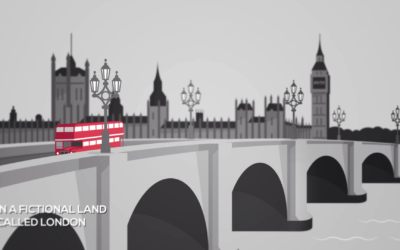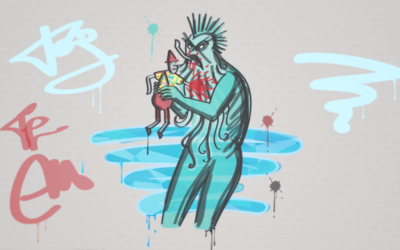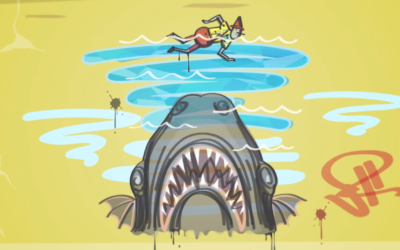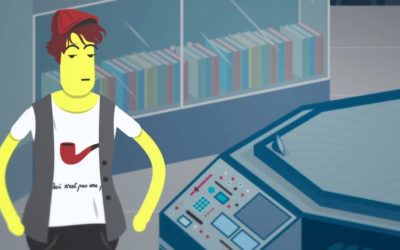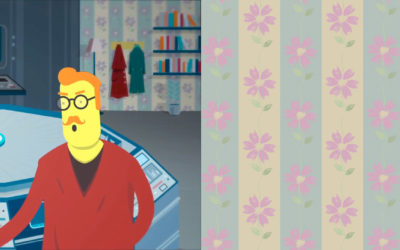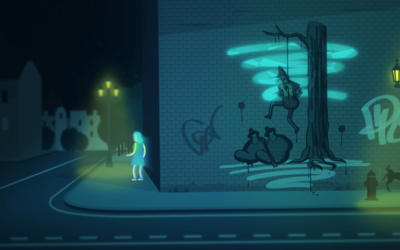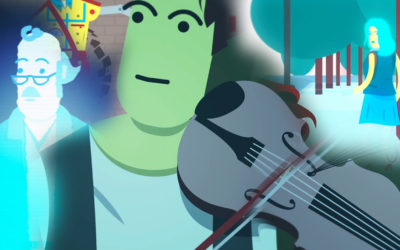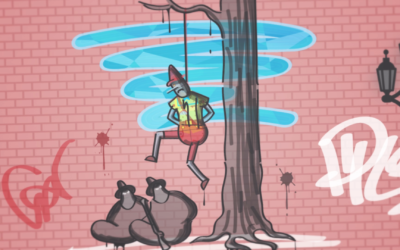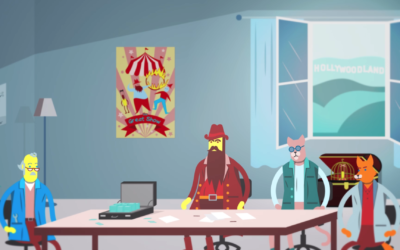3. THE BAKER STREET BUILDING
Sherlock Holmes and John Watson discuss Joseph’s case at 221B Baker Street. The above illustration is inspired by two sources: the fictional address of Holmes’ apartment in the Arthur Conan Doyle stories, and 187 North Gower Street, in London, where the BBC filmed exterior shots of Holmes’ building for its TV adaptation, Sherlock.
This Case File #3 explores the copyright status of buildings, designs and architectural plans, and considers when buildings can be copied by other creators, such as artists, photographers and film makers, without permission.
COPYRIGHT AND BUILDINGS
Architects depend on copyright to protect their work. While copyright protects different types of work, such as books, songs and films, works of architecture are protected as artistic works. A work of architecture is defined as ‘a building or a model for a building’, and a building is defined to include ‘any fixed structure, and a part of a building or fixed structure’. The term ‘structure’ is not defined in the legislation. The London Eye or the Nemesis rollercoaster at Alton Towers are good examples of structures that would qualify for copyright protection, but so too would more ordinary structures, such as a bridge, an outdoor swimming pool, or a garden that was landscaped to include features such as stone walls, steps and a pond.
It is important to note that in order to enjoy copyright in a building it does not need to be of a certain aesthetic or artistic quality. This means that even very simple buildings could, in theory, be protected by copyright. But, to attract copyright the work must be original, and so claiming copyright in a very simple building may be difficult.
CURIOSITY
Just as a building or a structure is protected by copyright, the architect’s drawings and plans (that is, the preparatory sketches for the building or structure) are also protected by their own copyright. Under the 1911 Copyright Act, these drawings, maps and plans were protected as if they were literary works. Today, they are protected under the Copyright Designs and Patents Act 1988 as artistic works.
THE CASE: Pearce v Ove Arup Partnership [2001] EWHC Ch 455
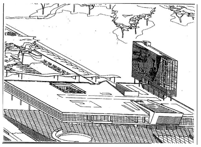 (Docklands) |
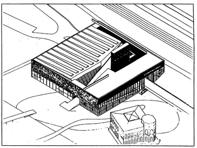 (Kunsthal) |
Infringement of copyright happens if a person copies the whole or a substantial part of a protected work without permission or without the benefit of a copyright exception. When dealing with works of architecture, however, it is not always so easy to establish that unlawful copying has taken place.
In this case the architect Rem Koolhaas designed the Kunsthal museum in Rotterdam, but was accused of copying the designs for a town hall in Docklands created by the claimant Gareth Pearce as part of his final year project for his Diploma in Architecture. The court had to decide if Mr Koolhaas had copied the Docklands plans.
Mr Pearce argued that there were a number of similarities between the Kunsthal designs and the Docklands plans which, taken together, established that Mr Koolhaas must have copied his designs.
The Court took a different view. Just because Mr Pearce had identified a number of similar dimensions between the two buildings did not mean anything. Acknowledging that architects were often limited in their options when trying to achieve a particular structure or effect, the judge observed that you could take thousands of measurements to compare the two different designs are many were bound to be similar. That did not mean there had been copying, or that the copying was infringing. All that Mr Pearce had established was ‘a collection of ‘similarities’ amounting individually and collectively to nothing’. ‘You do not have to be an architect,’ the judge said ‘to recognise the absurdity of the comparison as evidence of copying’. The case had ‘no foundation whatsoever’; it was ‘pure fantasy – preposterous fantasy at that.’
COPYING ARTISTIC WORKS ON PUBLIC DISPLAY
Although buildings are protected by copyright the law allows you to make copies of the building in certain circumstances. For example, you can make your own painting or drawing of a building, just as we have done in our video, without infringing copyright. You can also photograph it, or include it in a film. And, you can distribute copies of your work to the public or post it online.
Copyright law also lets you make copies of other types of artistic work on public display. For example, you can paint, draw, photograph and film works of sculpture permanently situated in a public place or in premises open to the public, such as The National Gallery or TATE Modern (although public galleries may rely on contract law to set their own rules about what you can or cannot photograph within the building).
FOR DISCUSSION: NOT ALL WORKS ARE EQUAL
Why does the law let you make copies of certain artistic works on public display, such as buildings and sculptures, but not all artistic works on public display?
Think of a gallery, open to the public, that contains paintings as well as works of sculpture, or what about public graffiti or a mural on a wall? Why do you think the law distinguishes between different types of artistic work in this way?
USEFUL REFERENCES:
Pearce v Ove Arup Partnership Ltd and Others [2001] EWHC Ch 455 is available here: http://www.bailii.org/ew/cases/EWHC/Ch/2001/455.html
The Copyright, Designs and Patents Act 1988 is available here: http://www.legislation.gov.uk/ukpga/1988/48/contents.
Section 4 provides the legal definition of artistic works, including works of architecture. Section 62 sets out which artistic works on public display can be copied and under what circumstances.
Download the PDF version of Case File #3 – The Baker Street Building.
More Case Files
1. The Red Bus
The Adventure of the Girl with the Light Blue Hair starts with a red double-decker bus travelling across Westminster Bridge, with the Houses of Parliament in the background.
2. The Monster
One of the graffiti that scare the toymaker Joseph portrays a monster eating his ‘beautiful, wonderful toy’. The image of the monster is inspired by two different artistic works
4. The Anonymous Artist
Joseph, the toymaker, has asked the police to identify the culprit making ‘dreadful images’ of his toy, portraying it in violent situations.
5. The Terrible Shark
This illustration from our video depicts a terrible shark-like creature about to eat Joseph’s toy. It was inspired by two different images…
6. The Famous Pipe
The pipe has been associated with the image of Sherlock Holmes since Sir Arthur Conan Doyle’s (1859 – 1930) stories were first published in The Strand Magazine with illustrations by Sidney Paget (1860 – 1908).
7. The Matching Wallpaper
In the background of Holmes and Watson’s apartment you can see wallpaper with ‘flowers scattered over it in a somewhat impressionistic style’.
8. The Dreadful Images
The ‘dreadful images’ that scare Joseph, the toymaker, are graffiti drawn all over the ‘fictional land called London’. The illustration above, depicting Joseph’s toy hung from a tree, is based on an actual place in London.
9. The Improbable Threat
In trying to persuade Holmes to take Joseph’s case, Watson asks: ‘What if it’s a threat? That’s what the graffiti might mean.’ These eleven words are based on dialogue from The Blind Banker…
10. The Uncertain Motivation
Joseph, Sherlock Holmes and the Girl with the Light Blue Hair are all creators: Joseph draws and designs toys; Sherlock composes music; and the mysterious girl is an accomplished street artist.
11. The Mutilated Work
In trying to persuade Holmes to take the case, Watson argues that: ‘If you were a professional musician, you wouldn’t want people copying or mutilating your work’.
12. The Hollywoodland Deal
Joseph explains to Holmes and Watson when and why the dreadful images of his beautiful, wonderful toy began to appear all over London. When ‘some guys’ from Hollywoodland approached him ‘to option a movie’…

